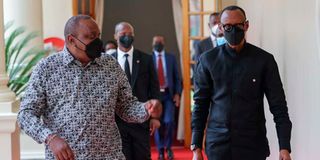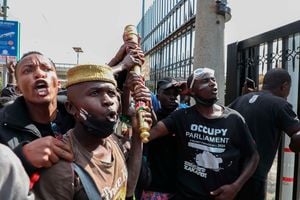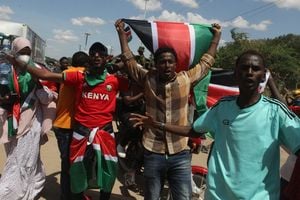When projects become big politics

President Uhuru Kenyatta with Rwanda’s President Paul Kagame at State House, Nairobi on February 3, 2022.
What you need to know:
- In the 2008 Kenya post-election violence, Ugandan trucks were attacked in the Rift Valley and western regions.
- It seems Kampala sees the railway, especially from Nairobi to Nakuru and on to Kisumu, as risky.
On February 3, Rwandan President Paul Kagame visited with Kenya’s President Uhuru Kenyatta in Nairobi. He posted a tweet about which, as of Tuesday, had received 20,300 Likes and 3,001 Retweets.
The most engaged tweet on President Kagame’s page since January 1, it said (abbreviations written out and punctuations added): “I had a brief but very productive working visit with President Uhuru Kenyatta in Nairobi this morning. Now back home! I like it this way — One hour to Nairobi; one hour back to Kigali. One hour and discussion. One hour from airport (JKIA) to (Nairobi) State House and back to airport. A lot was covered!!!”
Of the many comments, one understood that it had taken President Kagame one hour to get from Jomo Kenyatta International Airport (JKIA) to State House in Kilimani, and opined that that was simply unacceptable. Because the roads and streets would have been closed for the leader, with police sweepers ahead, it is likely it took him 30 minutes to get to State House and another 30 to return to the airport.
However, the point had been made: The short trip to and from JKIA (if your journey doesn’t allow you to get off on one of the by-passes) can be a nightmare. On a bad day, it can be two hours long just between Westlands and JKIA.
On some very bad days, with the disruption of the construction of the Nairobi Expressway to the airport, all night. When the expressway is opened, that distance will be slashed to 15 minutes for ordinary motorists.
What the expressway will do — at the basic level, domestically in Kenya — is ease traffic congestion. At a global level, however, it will make JKIA more competitive as an airport. In that way, it is part of the trend of the Africa infrastructure race.
Buy cheap power
It was evident on Sunday, when Ethiopia began generating power from its $4.5 billion (Sh450 billion) Grand Ethiopian Renaissance Dam (Gerd). As soon as this largest hydroelectric project in Africa was up, Ethiopia’s Ambassador to Kenya Meles Alem said Nairobi and Addis Ababa had begun talks on the latter’s plans to buy cheap power from across the border.
But we had a split-screen moment: Sudan protested the launch of generation, rejecting it as a “unilateral step” by Ethiopia. Sudan and Egypt have a long-running beef with Gerd, saying it is a threat to their national security because all they have as their main source of water is River Nile.
At the inauguration ceremony, Ethiopian Prime Minister Abiy Ahmed sought to assure Sudan and Ethiopia that their water supply is safe. “As you can see, this water will generate energy while flowing as it previously flowed to Sudan and Egypt — unlike the rumours that say the Ethiopian people and government are damming the water to starve Egypt and Sudan,” he said.
Ironically, the now-ebbing Tigray war in Ethiopia might have handed Abiy the leverage to switch on Gerd without losing sleep over Sudan’s and Ethiopia’s feelings.
At the height of the war in late 2020 and into half of 2021, when it looked as if the rebels might overwhelm Abiy’s government, Ethiopian officials and nationalists accused Sudan and Egypt of backing the Tigray insurgents. Cairo and Khartoum didn’t help matters by seeming to delight in Abiy’s troubles.
Abiy then donned military uniform and went to the front. The boost to morale, and a deadly deployment of drones, dramatically turned the war in his favour. They might not be defeated but the Tigrayans and their allies have been routed for now. And with that, Egypt and Sudan’s hands over the Gerd terms essentially collapsed.
Standard gauge railway
A similar play is happening with Kenya’s standard gauge railway (SGR), the recently extended line to Kisumu and the Kisumu Port. In Kenya itself, it seems there is little awareness of the stakes.
In the recent 75km truck snarl-up to the Malaba border, and a shorter one to Busia, which sent fuel prices in Uganda skyrocketing, Kampala officialdom took the opportunity to urge the country’s fuel industry to shift to railway and water transport from Kisumu to Port Bell. They showed how that would be several times cheaper.
But Fred Byamukama, state minister of works in charge of transport, let the cat out of the bag: “Has Uganda learnt or forgotten anything from its past experiences? With the Kenyan election in six months, can Uganda’s freshly opened economy afford another disruptive fuel crisis?”
In the 2008 Kenya post-election violence, Ugandan trucks were attacked in the Rift Valley and western regions. It seems Kampala sees the railway, especially from Nairobi to Nakuru and on to Kisumu, as risky, yes, but less so than the truck route beyond Nakuru to Malaba through Eldoret, should the August election go sideways.
To Uganda (and northern Tanzania), the renovated but perhaps underwhelming Nakuru-Kisumu line, and Kisumu Port, are a big deal — especially in the dark hours of Kenya’s electoral witching.
Mr Onyango-Obbo is a journalist, writer and curator of the “Wall of Great Africans”. @cobbo3





